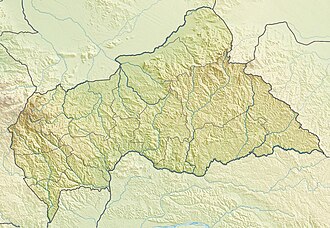Geography and environment
The park occupies most of the eastern end of Bamingui-Bangoran province in the north of the country. The park's northern boundary is the international border with Chad on the Aouk (Bahr) and Kameur Rivers. The eastern border is the Vakaga River, the western border is the Manovo River about 40 km (25 mi) east of N'Délé, and the southern border is the ridge of the Massif des Bongo. The Ndéle-Birao road runs through the park.
Threats
The site is under threat due to its rare wildlife dying and animals species being wiped out. The western black rhinoceros that was indigenous to the Central African Republic has gone extinct in 2011. The site was added to the List of World Heritage in Danger after reports of illegal grazing and poaching by heavily armed hunters, who may have harvested as much as 80% of the park's wildlife. The shooting of four members of the park staff in early 1997 and a general state of deteriorating security brought all development projects and tourism to a halt. [3]
The government of the Central African Republic proposed to assign site management responsibility to a private foundation. The preparation of a detailed state of conservation report and rehabilitation plan for the site was recommended by the World Heritage Committee at its 1998 session. People are working on breeding programs to revive the natural wildlife.
This page is based on this
Wikipedia article Text is available under the
CC BY-SA 4.0 license; additional terms may apply.
Images, videos and audio are available under their respective licenses.

